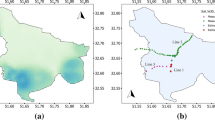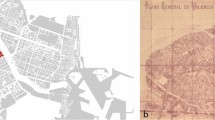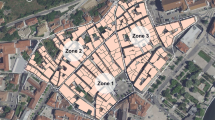Abstract
Seismic risk scenarios are obtained for an informal settlement in Mérida (Venezuela), which is representative of an important number of urban areas in earthquake-prone regions of the developing world. The vulnerability indices of the buildings range between 0.64 and 0.80 on a scale of 0 to 1. In an intensity IX earthquake scenario, more than 32% of the buildings would suffer damage of grade 4 (extensive) or greater. A structural analysis of the buildings in the study area shows that they are unsafe for gravity loads, and that the seismic demands exceed the strength of the constructions. Simple and comparatively inexpensive measures can improve the seismic performance of these buildings; the vulnerability can be reduced by about 51%. In an intensity IX earthquake scenario, the expected economic loss before retrofitting the buildings is US$5.36 million, with 275 fatalities; once retrofit has been carried out, the resulting figures are US$0.39 million and 10 fatalities. Retrofit would cost US$1.04 million, whereas reconstruction would cost US$19 million.














Similar content being viewed by others
Abbreviations
- A, B, C:
-
Levels of contribution to vulnerability of each of the parameters in the IVIM methodology
- B1, B2, B3-b, B3-c:
-
Prototype buildings representing the vast majority of constructions in “La Milagrosa”
- C :
-
Number of collapsed floors for a given input intensity (for estimating the number of casualties in Eq. 5)
- d :
-
Damage grade (Eq. 3)
- F i :
-
Lateral force demand on the i-th floor
- I :
-
Input intensity ranging from I (1) to XII (12)
- I V :
-
Vulnerability index in the IVIM methodology (Eq. 1)
- k :
-
Damage grade ranging from 0 (no damage) to 5 (destruction)
- K i :
-
Scoring coefficient of the i-th parameter in the IVIM methodology
- K iC :
-
Highest possible scoring coefficient of the i-th parameter in the IVIM methodology
- K s :
-
Number of casualties for a given input intensity (Eq. 5 )
- M1, M2, M3, M4, M5:
-
Parameters representing the number of fatalities in an earthquake scenario (Eq. 5)
- R :
-
Response reduction factor in the code-type seismic analysis
- T :
-
Fundamental period of a building
- VI :
-
NVIM vulnerability index (ranging from 0 to 1)
- W i :
-
Weighting factor of the i-th parameter in the IVIM methodology, weight of the i-th floor
- μ d :
-
Mean damage grade (Eq. 4)
References
ACI Committee 318 (2002) Building code requirements for structural concrete (ACI 318-02) and commentary. American Concrete Institute, Detroit
Angeletti P, Bellina A, Guagenti E, Moretti A, Petrini V (1988) Comparison between vulnerability assessment and damage index, some results. In: Proceedings of the 9th world conference on earthquake engineering, Tokyo- Kyoto, Japan
ATC-13 (1985) Earthquake damage evaluation data for California. Applied Technology Council, Redwood City
ATC-40 (1996) Seismic evaluation and retrofit of concrete buildings, Technical report, Applied Technology Council, Redwood City, California
Angeletti P, Bellina A, Guagenti E, Moretti A, Petrini V (1988) Comparison between vulnerability assessment and damage index, some results. In: Proceedings of the 9th world conference on earthquake engineering, Tokyo- Kyoto, Japan
Barbat AH, Yépez F, Canas JA (1996) Damage scenarios simulation for seismic risk assessment in urban zones. Earthq Spectra 12(3):371–394
Barbat AH, Mena U, Yépez F (1998) Evaluación probabilista del riesgo sísmico en zonas urbanas. Revista internacional de métodos numéricos para cálculo y diseño en ingeniería 14(2):247–268
Barbat AH, Lagomarsino S, Pujades LG. (2006a) Vulnerability assessment of dwelling buildings. In: Sousa C, Roca A, Goula X (eds) Assessing and managing earthquake risk. Dordrecht
Barbat AH, Pujades LG, Lantada N, Moreno R (2006b) Performance of buildings under earthquake in Barcelona, Spain. Compu-Aided Civil Infrastrut Eng 21:573–593
Barbat AH, Pujades LG, Lantada N, Moreno R (2008) Seismic damage evaluation in urban areas using the capacity spectrum method: application to Barcelona. Soil Dynamics Earthq Eng 28(10–11):851–865
Barbat AH, Carreño ML, Pujades LG, Lantada N, Cardona OD, Marulanda MC (2009) Seismic vulnerability and risk evaluation methods for urban areas. A review with application to a pilot area. Struct Infrastrut Eng 6(1):17–38
Bolívar (Coordinator) T (1994) Densificación y vivienda en los barrios Caraqueños. Contribución a la determinación de problemas y soluciones, Consejo Nacional de la Vivienda (CONAVI). Ministerio de Desarrollo Urbano, Caracas
Carreño ML, Cardona OD, Barbat AH (2007) Urban seismic risk evaluation: a holistic approach. Nat Hazards 40:137–172
Castillo A (2006) Seismic risk scenarios for buildings in Mérida, Venezuela. Detailed vulnerability assessment for non-engineered housing, Doctoral Dissertation, Technical University of Catalonia, Barcelona. Available online at: http://www.tdx.cat/TDX-0303106-104140 (last accessed November 2nd, 2010)
City Univ. of London (2005) Low-rise residential construction detailing to resist earthquakes, http://www.staff.city.ac.uk/earthquakes/Repairstrengthening/RSBrickMasonry.htm (last accessed November 2nd, 2010)
Coburn A, Spence R (1992) Earthquake protection. Wiley, NJ
Coburn A, Spence R (2002) Earthquake protection, 2nd edn. Wiley, NJ
Dolce M, Kappos A, Masi A, Penelis G, Vona M (2006) Vulnerability assessment and earthquake damage scenarios of the building stock of Potenza (Southern Italy) using Italian and Greek methodologies. Eng Struct 28:357–371
EERI/IAEE (2005) Encyclopedia of housing construction types in seismically prone areas of the world. Earthquake Engineering Research Institute—International Association of Earthquake Engineering. At website: http://www.world-housing.net/index.asp
ENV-1996 (1996) Design of masonry structures. European Committee for Standardization
FEMA/NIBS (2002) HAZUS technical manual -SR2. Federal Emergency Management Agency and National Institute of Building Sciences, Washington
Giovinazzi S, Lagomarsino S (2004) A macroseismic method for the vulnerability of buildings. In: Proceedings of the 13th world conference on earthquake engineering, Vancouver
Giovinazzi S (2005) The vulnerability assessment and the damage scenario in seismic risk analysis, PhD Dissertation, University of Florence. Italy. Electronic version online available at: http://bib1lp1.rz.tu-bs.de/docportal/content/below/index.xml
GNDT (2001) Scheda di Vulnerabilità Di 2° Livello (Calcestruzzo Armato) and Scheda di Vulnerabilità Di 2° Livello (Muratura), Downloaded at Gruppo Nazionale per la Difessa dai Terremoti: www.ingv.it/gndt/Strumenti/Schede/Schede_vulnerabilita/scheda_secondo_livello_mur.pdf
Grünthal G (1998) European Macro-seismic Scale 1998, Centre Européen de Géodynamique et Séismologie, Cahiers du Centre Européen de Géodynamique et de Séismologie
IAEE (2001) Guidelines for earthquake resistant non-engineered construction. Int As Earthquake Eng
ISDR (International Secretariat for Disaster Reduction) (2001) Countering disasters; targeting vulnerability, information kit of the 2001 World Disaster Reduction Campaign, United Nations. At website: http://www.unisdr.org/unisdr/camp2001.htm
Lagomarsino S, Giovinazzi S (2006) Macroseismic and mechanical models for the vulnerability and damage assessment of current buildings. Bull Earthq Eng 4:415–443
Lantada N, Pujades LG, Barbat AH (2009) Vulnerability index and capacity spectrum based methods for urban seismic risk evaluation, a comparison. Nat Hazards 51:501–524
Lantada N, Irizarry J, Barbat AH, Goula X, Roca A, Susagna T, Pujades LG (2010) Seismic hazard and risk scenarios for Barcelona, Spain, using the Risk-UE vulnerability index method. Bull Earthq Eng 8:201–229
Magenes G, Calvi GM (1997) In-plane seismic response of brick masonry walls. Earthq Eng Struct Dynamics 26(11):1091–1112
Milutinovic ZV, Trendafiloski GS (2003) Vulnerability of current buildings, Work-Package 4 of RISK_UE Project. European Commission, EVK4-CT-2000-00014
MINDUR and FUNVISIS (1998) Norma COVENIN 1756–98. Edificaciones Sismorresistentes. Dirección General Sectorial de Equipamiento del Ministerio de Desarrollo Urbano, Fundación Venezolana de Investigaciones Sísmicas, Caracas
Murty CVR, Brzev S, Faison H, Comartin CD, Irfanoglu A (2006) At risk: the seismic performance of reinforced concrete frame buildings with masonry infill walls. Earthquake Engineering Research Institute—International Association of Earthquake Engineering
Musson RMW, Grünthal G, Stucchi M (2010) The comparison of macroseismic intensity scales. J Seismol 14(2):413–428
Paulay T, Priestley MNJ (1992) Seismic design of reinforced concrete and masonry buildings. John Wiley, NJ
Park J, Towashiraporn P, Craig JI, Goodno BJ (2009) Seismic fragility analysis of low-rise unreinforced masonry structures. Eng Struct 31:125–137
Pérez O (1998) Seismological report on the M w = 6.8 strong shock of 9 July 1997 in Cariaco, Northeastern Venezuela. Bull Seismol Soci Am 31(3):874–879
Pujades LG, Barbat AH, González-Drigo R, Ávila J, Lagomarsino S (2010) Seismic performance of a block of buildings representative of the typical construction in the example district in Barcelona (Spain). Bull Earthquake Eng doi:10.1007/s10518-010-9207-5 (in press, published online September 15, 2010)
Sidetur (2004) Losas de tabelones, Siderúrgica del Turbio S.A. http://www.sidetur.com.ve
Vacareanu R, Lungu D, Aldea A, Arion C (2004) Seismic scenarios handbook, RISK-UE LM1
Valluzzi MR, Binda L, Modena C (2005) Mechanical behavior of historic masonry structures strengthened by bed joints structural repointing. Construct Build Mater 19:63–73
Yépez F (1996) Methodology for risk and vulnerability assessment of structures applying simulation techniques (in Spanish), Doctoral Dissertation, Technical University of Catalonia, Barcelona
Acknowledgments
The thorough revision of the paper of two anonymous referees is greatly appreciated. The thoughtful comments and suggestions of the reviewers helped to improve the manuscript. This work was supported by the Spanish Government under projects CGL-2005-04541-C03-03 and CGL2008-00869/BTE, which receive ERDF funding from the European Commission. A. Castillo received funding for the period of research spent in Barcelona from the Venezuelan National Council for Scientific and Technological Research (CONICIT), under grant #199601500.
Author information
Authors and Affiliations
Corresponding author
Rights and permissions
About this article
Cite this article
Castillo, A., López-Almansa, F. & Pujades, L.G. Seismic risk analysis of urban non-engineered buildings: application to an informal settlement in Mérida, Venezuela. Nat Hazards 59, 891–916 (2011). https://doi.org/10.1007/s11069-011-9805-9
Received:
Accepted:
Published:
Issue Date:
DOI: https://doi.org/10.1007/s11069-011-9805-9




